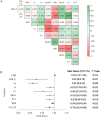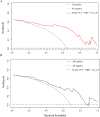Early changes in laboratory tests predict liver function damage in patients with moderate coronavirus disease 2019: a retrospective multicenter study
- PMID: 35264110
- PMCID: PMC8905025
- DOI: 10.1186/s12876-022-02188-y
Early changes in laboratory tests predict liver function damage in patients with moderate coronavirus disease 2019: a retrospective multicenter study
Abstract
Background: Most patients with coronavirus disease 2019 demonstrate liver function damage. In this study, the laboratory test data of patients with moderate coronavirus disease 2019 were used to establish and evaluate an early prediction model to assess the risk of liver function damage.
Methods: Clinical data and the first laboratory examination results of 101 patients with moderate coronavirus disease 2019 were collected from four hospitals' electronic medical record systems in Jilin Province, China. Data were randomly divided into training and validation sets. A logistic regression analysis was used to determine the independent factors related to liver function damage in patients in the training set to establish a prediction model. Model discrimination, calibration, and clinical usefulness were evaluated in the training and validation sets.
Results: The logistic regression analysis showed that plateletcrit, retinol-binding protein, and carbon dioxide combining power could predict liver function damage (P < 0.05 for all). The receiver operating characteristic curve showed high model discrimination (training set area under the curve: 0.899, validation set area under the curve: 0.800; P < 0.05). The calibration curve showed a good fit (training set: P = 0.59, validation set: P = 0.19; P > 0.05). A decision curve analysis confirmed the clinical usefulness of this model.
Conclusions: In this study, the combined model assesses liver function damage in patients with moderate coronavirus disease 2019 performed well. Thus, it may be helpful as a reference for clinical differentiation of liver function damage. Trial registration retrospectively registered.
Keywords: Carbon dioxide combining power; Coronavirus disease 2019; Liver function; Nomogram; Plateletcrit; Predict; Retinol-binding protein.
© 2022. The Author(s).
Conflict of interest statement
The authors declare that they have no competing interests.
Figures




Similar articles
-
Construction and validation of a machine learning-based nomogram: A tool to predict the risk of getting severe coronavirus disease 2019 (COVID-19).Immun Inflamm Dis. 2021 Jun;9(2):595-607. doi: 10.1002/iid3.421. Epub 2021 Mar 13. Immun Inflamm Dis. 2021. PMID: 33713584 Free PMC article.
-
Exploiting an early warning Nomogram for predicting the risk of ICU admission in patients with COVID-19: a multi-center study in China.Scand J Trauma Resusc Emerg Med. 2020 Oct 27;28(1):106. doi: 10.1186/s13049-020-00795-w. Scand J Trauma Resusc Emerg Med. 2020. PMID: 33109234 Free PMC article.
-
An interactive nomogram to predict healthcare-associated infections in ICU patients: A multicenter study in GuiZhou Province, China.PLoS One. 2019 Jul 15;14(7):e0219456. doi: 10.1371/journal.pone.0219456. eCollection 2019. PLoS One. 2019. PMID: 31306445 Free PMC article.
-
A Tool for Early Prediction of Severe Coronavirus Disease 2019 (COVID-19): A Multicenter Study Using the Risk Nomogram in Wuhan and Guangdong, China.Clin Infect Dis. 2020 Jul 28;71(15):833-840. doi: 10.1093/cid/ciaa443. Clin Infect Dis. 2020. PMID: 32296824 Free PMC article.
-
Interrelationship Between Coronavirus Infection and Liver Disease.Clin Liver Dis (Hoboken). 2020 May 21;15(5):175-180. doi: 10.1002/cld.967. eCollection 2020 May. Clin Liver Dis (Hoboken). 2020. PMID: 32489653 Free PMC article. Review. No abstract available.
Cited by
-
Liver damage in the context of SARS-CoV-2. Covid-19 treatment and its effects on the liver.J Med Life. 2022 Jun;15(6):727-734. doi: 10.25122/jml-2022-0177. J Med Life. 2022. PMID: 35928369 Free PMC article. Review.
-
Clinical Predictors for Abnormal ALT in Patients Infected with COVID-19-A Retrospective Single Centre Study.Pathogens. 2023 Mar 16;12(3):473. doi: 10.3390/pathogens12030473. Pathogens. 2023. PMID: 36986395 Free PMC article.
-
Analysis of risk factors for sepsis-related liver injury and construction of a prediction model.Front Public Health. 2024 Dec 6;12:1475292. doi: 10.3389/fpubh.2024.1475292. eCollection 2024. Front Public Health. 2024. PMID: 39712312 Free PMC article.
-
Evaluation of Trace Elements Levels and Construction of Auxiliary Prediction Model in Patients with Diabetes Ketoacidosis in Type 1 Diabetes.Diabetes Metab Syndr Obes. 2023 Oct 30;16:3403-3415. doi: 10.2147/DMSO.S425156. eCollection 2023. Diabetes Metab Syndr Obes. 2023. PMID: 37929055 Free PMC article.
-
The Efficacy and Safety of Shashen-Maidong Decoction Combined with Western Medicine in the Treatment of Omicron Infected Individuals Over 85 Years Old: A Retrospective Study.Infect Drug Resist. 2023 Nov 28;16:7339-7348. doi: 10.2147/IDR.S433815. eCollection 2023. Infect Drug Resist. 2023. PMID: 38045652 Free PMC article.
References
-
- WHO Coronavirus Disease (COVID-19) Dashboard. https://covid19.who.int/. Accessed 10 Jan 2020.
Publication types
MeSH terms
Grants and funding
LinkOut - more resources
Full Text Sources
Medical

